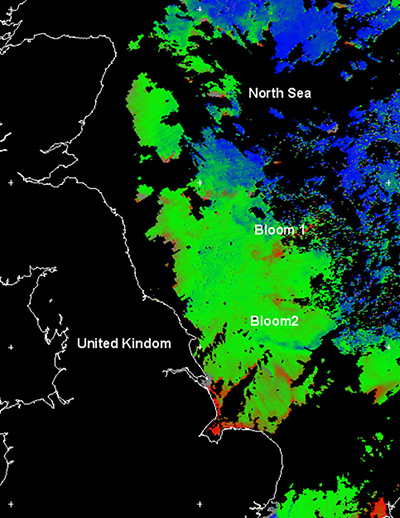Customer
Centre for Environment, Fisheries and Aquaculture Science (Cefas), UK
Mission Location
Off the coast of Lincolnshire, UK
Highlights
- Added a Cefas Water Sampler on the Wave Glider to give the team a mobile, responsive solution for on-demand autonomous water sampling
- Remotely commanded the water sampler onboard to take two samples that have since been confirmed to contain the phytoplankton Karenia sp.
- Successful mission conducted over 48 days and 2,700km at sea in difficult navigational environment
“The ability to collect samples on demand enables us to better target areas of scientific interest, potentially allowing us to collect specific samples more efficiently. I am excited about the future of autonomous vehicles, such as the Wave Glider, as innovative ways to meet our scientific and monitoring goals.”
The Challenge
Harmful algal blooms (HABs) can kill fish, mammals and birds, and contaminate water and shellfish that make people sick. Satellite imaging can detect these blooms, but cloud cover adversely affects coverage and so it is not unusual to go several days without a good image covering shelf sea areas such as the southern North Sea. In addition, the colonies often disappear before the next good image is available, possibly due to predation, a diminishing supply of nutrients, or simply sinking below the water surface.
The Centre for Environment, Fisheries and Aquaculture Science (Cefas) needed a way to track and sample algal blooms in the right place at the right time. If they could confirm the presence of the Karenia sp. dinoflagellate—known to produce toxins that can cause significant mortality in fish—within an algal bloom, then they could help improve the satellite algorithms used in the production of satellite products. This, in the longer term, offers improvements in the remote detection of HABs.
The Approach
Dr. David Pearce, Cefas’ Marine Observations Systems Manager and the officer in command of this mission, was looking for a way to collect samples on demand, in areas of particular interest based on satellite data. Previous approaches, included the Cefas water sampling sensor integrated into its SmartBuoys or on a ship, but these approaches were limited by lack of mobility or cost and control, respectively. By integrating the Cefas Water Sampler onto the Wave Glider, and engaging the Liquid Robotics Operations Team to remotely pilot it 24/7, the team had a mobile, responsive solution for on-demand autonomous water sampling.
The Wave Glider was deployed in the southern North Sea about 60km off Lincolnshire, UK coastline. Using experimental daily satellite images of a harmful algal bloom (courtesy of NEODAAS, Plymouth Marine Laboratory), Cefas scientists navigated the Wave Glider to a small suspected bloom of Karenia sp. north of the Dogger Bank. Once in the area of the bloom, scientists monitored the near-real time data from the on-board chlorophyll sensor to confirm its presence. They then commanded the water sampler onboard to take two samples that have since been confirmed to contain the phytoplankton Karenia sp.

MODIS Aqua experimental satellite image showing possible Karenia blooms north and south of the Dogger (courtesy of NEODAAS, Plymouth Marine Laboratory)
The Results
The remote triggering of the Cefas Water Sampler was a success, and it is believed to be the world’s first “on-demand” marine water sampling using an unmanned surface vehicle. Scientists collected 11 samples, on demand, over the duration of the mission by sending commands over the Iridium satellite network to the Wave Glider.
The area in which the Wave Glider operated successfully was extremely challenging for an unmanned surface vehicle. Over 48 days and 2700 km at sea, the Wave Glider had to contend with strong currents, navigate around many shallow sandbanks in the southern North Sea, and avoid numerous ships and stationary gas platforms.
What’s Next?
Cefas scientists are now planning to use the Cefas Water Sampler on additional upcoming Wave Glider missions. The sampler can be used to pump out “tracer” material. When combined with the on-board sensors, this extends the research applications of this innovative technology to, for example, mapping localized areas of sea surface. The Wave Glider expands Cefas’ research and monitoring capabilities in areas such as water quality monitoring, fisheries assessments, aquaculture health and ambient noise measurement.
 We demonstrated that there is great potential in smart solutions for monitoring ocean conditions and I am excited about the future of autonomous vehicles, such as the Wave Glider, as innovative ways to meet our scientific and monitoring goals.”
We demonstrated that there is great potential in smart solutions for monitoring ocean conditions and I am excited about the future of autonomous vehicles, such as the Wave Glider, as innovative ways to meet our scientific and monitoring goals.”